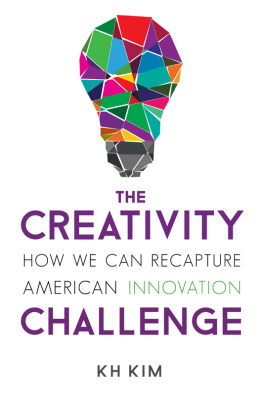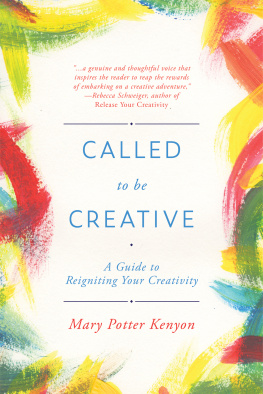
UNLOCKED
Assessment as the Key to Everyday Creativity in the Classroom
KATIE WHITE

Copyright 2019 by Solution Tree Press
Materials appearing here are copyrighted. With one exception, all rights are reserved. Readers may reproduce only those pages marked Reproducible. Otherwise, no part of this book may be reproduced or transmitted in any form or by any means (electronic, photocopying, recording, or otherwise) without prior written permission of the publisher.
555 North Morton Street
Bloomington, IN 47404
800.733.6786 (toll free) / 812.336.7700
FAX: 812.336.7790
email:
SolutionTree.com
Visit go.SolutionTree.com/assessment to download the free reproducibles in this book.
Printed in the United States of America

Library of Congress Cataloging-in-Publication Data
Names: White, Katie, 1970- author.
Title: Unlocked : assessment as the key to everyday creativity in the classroom / Katie White.
Description: Bloomington, IN : Solution Tree Press, 2018. | Includes bibliographical references and index.
Identifiers: LCCN 2018030288 | ISBN 9781947604513 (perfect bound)
Subjects: LCSH: Learning--Evaluation. | Students--Rating of. | Creative ability--Study and teaching. | Motivation in education.
Classification: LCC LB3051 .W48847 2018 | DDC 371.26--dc23 LC record available at https://lccn.loc.gov/2018030288
Solution Tree
Jeffrey C. Jones, CEO
Edmund M. Ackerman, President
Solution Tree Press
President and Publisher: Douglas M. Rife
Editorial Director: Sarah Payne-Mills
Art Director: Rian Anderson
Managing Production Editor: Kendra Slayton
Senior Production Editor: Tara Perkins
Senior Editor: Amy Rubenstein
Copy Editor: Ashante K. Thomas
Proofreader: Jessi Finn
Text and Cover Designer: Abigail Bowen
Editorial Assistant: Sarah Ludwig
ACKNOWLEDGMENTS
After every venture into the realm of writing, it is important for me to stand back and acknowledge the experiences and the relationships that have led to a single book. For this work in particular, the words merely attempt to capture what feels like a lifetime of creative learning alongside the people in my life.
First of all, I must acknowledge my art students. I started teaching art classes when I was eighteen years old, and all the years of working with young artists have taught me so much about the creative processhow it flourishes and how it collapses in on itself. I am so grateful for all the children, youth, and adults who helped me figure out how to encourage innovation and risk taking while still having fun.
I also wish to acknowledge other groups of students. There were those who sat in my mathematics classes when I tried zany ways of making sense of things. There were students who learned alongside me in science classes when we tried, failed, and tried again. There were the students who trusted me in English language arts classes as we explored ways to write well, weaving stories out of lifes experiences. Teachers are learners first, and I am so grateful for all the learning I did in my classrooms over the years. Creativity followed me everywhere, and my students were always up for the challenge.
I have to acknowledge the Solution Tree team, who exercise tremendous patience as I work through my own creative process. Always thorough and encouraging, and always helping me bring a coherent message to my work, I thank this team for everything they do, from editing, to cover design, to publicity. This book would not be a book without you.
Lastly, I have to acknowledge my highly creative family, who not only live with but also support my creative inclinations every day. From my mom, who is the most creative person I know, to my literary father, to my musician husband, to my incredibly creative daughters (in pretty much every way possible), my life is full and rich and wonderful because of you.
Solution Tree Press would like to thank the following reviewers:
Kristi Bundy
Sixth-Grade Teacher
Ashland-Greenwood Middle School
Ashland, Nebraska
Jeff Byrnes
Principal
Mountain Meadow Elementary School
Buckley, Washington
Sarah Carter
Mathematics Teacher
Coweta High School
Coweta, Oklahoma
Megan Grube
Director of Curriculum, Instruction, and Technology
Grand Isle Supervisory Union
North Hero, Vermont
Kathy Nimmer
English Teacher, Constructional Coach
William Henry Harrison High School
West Lafayette, Indiana
Amber Webb
Stage I Teacher
The Roeper School
Bloomfield Hills, Michigan
Tracy Williams
Principal
W.G. Mallett School
Farmington, Maine
Visit go.SolutionTree.com/assessment to download the free reproducibles in this book.
TABLE OF CONTENTS
Reproducible pages are in italics.
ABOUT THE AUTHOR
Katie White is coordinator of learning for the North East School Division in Saskatchewan, Canada, and an educational consultant. With more than twenty years in education, she has been a district and in-school administrator, a learning coach, and a K12 classroom teacher.
Katie was an integral part of her school divisions multiyear journey through renewed curricula and standards-based assessment and reporting. She helps develop and utilize strong assessment and grading practices that support teaching and learning in classrooms. Her focus is on helping educators develop a personalized understanding of the connections between curriculum, assessment, and instruction. Katie has developed multiple supports for teachers and administrators as well as facilitators of school-based professional learning. She is a co-moderator of the All Things Assessment (#ATAssess) Twitter chat and a frequent contributor to the All Things Assessment blog (http://allthingsassessment.info/blog).
Katie received a bachelor of education and master of education in curriculum studies from the University of Saskatchewan.
To learn more about Katies work, visit www.kwhiteconsulting.com, or follow her @KatieWhite426 on Twitter.
To book Katie White for professional development, contact .
INTRODUCTION
Early in my career as a teacher of senior art, when I had large classes, I talked myself out of using one-on-one formative assessment and feedback strategies, such as conferencing, to advance creative thinking, because I figured I simply did not have the time. Furthermore, I wondered what the other students would do when I was speaking with individuals about their work. How could I make sure all students completed my assignments and cared for my art materials when I was working with a single student? So, in the beginning, I skipped conferences, simply assigned student artwork a summative grade, and called it a day. However, I began to change my mind as the years progressed.
Next page















